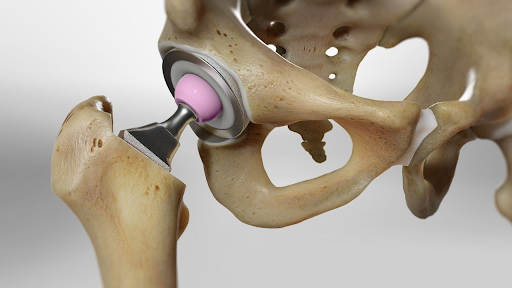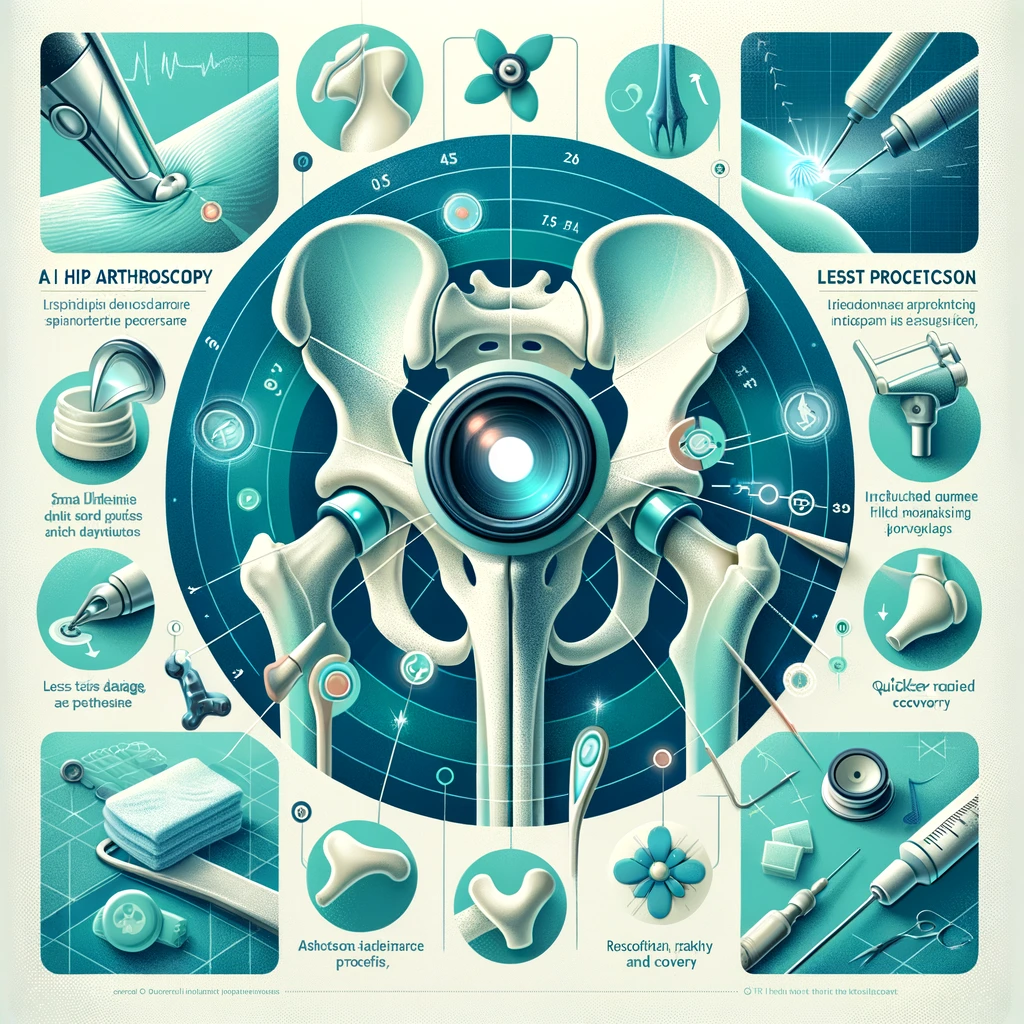Hip Arthroplasty Surgery
Hip arthroscopy is a minimally invasive surgical procedure used to identify and treat hip joint disorders. In this procedure, the surgeons will use a specialized device or an arthroscope to view the hip joint, allowing the removal of damaged cartilage, repair of labral tears, and correction of impingements. Compared to traditional open surgery this procedure offers shorter recovery, decreased pain, and improved mobility. This procedure is frequently used for diagnosing and treating hip pain, instability, and limited range of motion.it is crucial to consult an orthopedic specialist to determine whether hip arthroscopy is an appropriate treatment option for your specific hip condition. Read on to know more.
Procedure Name Hip Arthroscopy
Surgery Type Minimally Invasive Surgery
Hospital Stay Nil (Outpatient Procedure)
Duration of Surgery 1.5 to 2 Hours
Type of Anaesthesia Regional/General Anesthesia
Full Recovery 6 to 12 Months
What is Hip Arthroscopy?
Hip arthroscopy is a procedure that is used to both diagnose and treat certain conditions of the hip. An arthroscopy is a minimally invasive surgical procedure that uses small incisions and cameras to gain access and evaluate the inside of a joint. A camera is guided into the joint with multiple small incisions and small tools to correct or create a certain condition inside the joint. Orthopedic Surgeons can fix whatever is damaged inside the hip such as the labrum, and cartilage. The surgeon may also repair for conditions such as hip impingement, or loose fragments in the joint. The procedure is much less invasive than traditional open surgeries which calls for a much quicker recovery time, less pain, and an overall improved mobility of the joint.

Who Needs Hip Arthroscopy?
Hip arthroscopy is usually suggested for those with hip discomfort or dysfunction due to certain conditions that can be treated with a minimally invasive procedure. The following are the common reasons for hip arthroscopy:
- Lebral tear: Tearing the cartilage that rims the hip socket, thus leading to hip pain or abnormal hip function
- Femoroacetabular Impingement (FAI): FAI is the result of improper contact between the hip ball and the socket, which may lead to discomfort and even injury to the joint.
- Hip Dysplasia: This is the condition of instability and cartilage damage in the hip due to the abnormal development hip joint.
- Synovitis: An arthroscopy procedure is necessary for treating hip joint lining inflammation, which can cause discomfort and stiffness.
- Loose Bodies: Floating particles of bone or cartilage within the hip joint may be uncomfortable and mechanically problematic, thus they need to be removed.
- Hip infection: Hip arthroscopy may be used as a diagnostic tool for detecting and treating including my new Portuguese hip due to infection
Hip Arthroscopy vs Hip Replacement
Hip Arthroscopy
- Minimally invasive procedure.
- They are used in the identification and treatment of particular hip joint conditions.
- Resolves conditions such as impingement, labral tear, and loose bodies.
- Offers faster recovery, reduced pain, and enhanced mobility.
- Commonly done in younger patients who are localized with hip issues.
Hip Replacement
- Major surgery that involves a replacement of the hip joint.
- Specifically for severe hip arthritis or destruction of joints.
- A prosthetic implant replaces the damaged portions of the hip joint.
- Involves a longer recovery period, but delivers better function and long-term pain relief.
- This is more typical for older people with significant hip degeneration.
What Does Hip Arthroscopy Treat?
The following hip joint conditions are treated by hip arthroscopy:
- Labral tears: The labrum is a ring of cartilage around the hip socket, the tear of which can cause pain and instability. Hip arthroscopy helps repair labral tears or damaged labral tissue.
- Femoroacetabular impingement (FAI): An abnormal contact between the hip ball and socket can lead to impingement causing pain. Hip arthroscopy helps reshape the bones and alleviate pain.
- Loose bodies: Small bone fragments and loose tissue can cause pain and limitations in movement. Arthroscopy allows their removal thereby alleviating the symptoms.
- Synovitis: Arthroscopy helps treat the inflammation of the synovium, a fluid-filled sac in the hip.
- Cartilage damage: Arthroscopy also helps manage any damage to the articular cartilage, reserving joint health.
- Hip dysplasia: An abnormal hip joint development can lead to instability. Hip arthroscopy can help in the realignment of the hip joint for better stability.
- Occasional hip infections: Arthroscopy can be used for joint lavage (flushing) and debridement in the case of infections.
- Hip pain and dysfunction: A hip arthroscopy can help visualize and analyze any unexplained pain or dysfunction of the hip joint.
It is important to consult with an orthopedic surgeon to understand if a hip arthroscopy is suitable for your specific hip condition.
Why is a Hip Arthroscopy Done?
A hip arthroscopy is a minimally invasive procedure that is employed in both diagnostic and therapeutic interventions. Scenarios, where a hip arthroscopy is recommended, include:
- Diagnosis: Hip arthroscopy can help accurately diagnose the source of your hip pain or discomfort if other tests, such as an X-ray or MRI, fail to give a definitive answer to the cause of your symptoms.
- Treatment: Several hip joint conditions that have been successfully treated using hip arthroscopy include labral tears, femoroacetabular impingement (FAI), loose bodies, and some types of cartilage damage or injury.
- To relieve pain & improve function: The main goal of hip arthroscopy is to alleviate chronic hip pain and to improve joint function and overall quality of life.
Compared to traditional open surgery, hip arthroscopy offers several benefits, including a faster postoperative recovery, less scarring, and less postoperative pain. Based on the patient’s specific hip condition and symptoms, an orthopedic surgeon will make a final decision on the need for a hip arthroscopy.

How To Prepare For A Hip Arthroscopy?
To ensure a smooth and successful procedure, a few guidelines must be followed:
- Consultation: You will meet with your orthopedic surgeon before your procedure to discuss your medical history, undergo a physical examination, and have the opportunity to ask any questions about the surgery.
- Medical evaluation: If you experience any health issues between the time you schedule your procedure and your surgery date, it is important to notify your surgeon. Evaluation may include a medical history evaluation, a physical examination, and possibly a visit to your primary care doctors for additional tests.
- Medications: Inform your surgeon about any medications you are taking, including prescriptions, over-the-counter medications, and supplements. You might need to stop taking some medication before surgery.
- Fasting: Generally, patients will be advised to avoid food or drinks after midnight on the day before the surgery.
- Anesthesia: Before the surgery, you may discuss anesthetic choices with your anesthesia specialist.
- Arrangements: Make sure you arrange for a friend or a family member to drop you off at the hospital and also to drive you back home.
- Recovery space: Prepare your home in such a way that it is a safe space for your recovery. Make sure you have a stable chair with a firm cushion, a footstool, and a firm back both proper chairs and stool
Follow your healthcare provider’s guidelines strictly to ensure a successful procedure.
Hip Arthroscopy Surgery Procedure
Hip arthroscopy is a minimally invasive surgical procedure, which involves the following steps:
- Patient Positioning: Patients will be positioned on an operating table, typically in a lateral decubitus (side) or supine (on your back) position. This position depends on the surgeon's preference and the procedure being performed.
- Anesthesia: You will be generally administered anesthesia in order to make the procedure painless. You will be asleep during the procedure.
- Incisions: Normally 1-2 incisions about 5 - 10 mm in length are made around the hip joint.
- Arthroscope Insertion: A small, flexible tube called an arthroscope is inserted through one of the incisions. An arthroscope is a slender tool consisting of a light source and a camera. This tool shows the inside of your hip joint up close on monitors in the operating room.
- Surgical exploration: The surgeon will take a look at the cartilage, labrum, bones, and other structures in your hip joint.
- Treatment: Treatment can be done in several ways depending on what the defect. They can access the joint and then perform a variety of procedures such as repairing labral tears, removing loose bodies, and for the treatment of FAI reshaping the bones.
- Closure: Once the procedure is complete, the instruments are taken out and sutures or adhesive strips are used to close the incisions. Sterile dressings and bandages are placed over the incision sites.
- Recovery: After your procedure, you will be taken to a recovery area where you will be closely monitored by our nursing staff until you are fully awake and comfortable.
Most of the patients who had a hip arthroscopy can return home on the same day. In some cases depending on your specific condition you might need an overnight stay at the hospital.

Recovery and Outlook
The recovery and outlook after a hip arthroscopy may vary based on the particular treatment done, and the patient’s overall health. Here’s the general overview:
- Instant Recovery: Initial recuperation involves resting, icing, and raising the hip to reduce swelling and manage pain.
- Weight-Bearing: You may have weight restrictions on the operated leg for a certain length of time after surgery; this depends on the procedure performed.
- Physical therapy: Physical therapy is vital for strengthening and restoring hip mobility. Make sure you follow the prescribed exercise protocol.
- Pain Management: At first, pain medication may be prescribed. Gradually, it’s reduced as you recover.
- Returning to activities: The return to normal activities and sports varies for each individual. It may take several weeks to months.
- Expectations: Many patients experience improved hip function, decreased pain, and a better quality of life after a hip arthroscopy.
- Follow-up appointments: Attend follow-up appointments with your surgeon as scheduled to monitor your progress and address any questions or concerns.
The specific procedure carried out and your level of commitment to the post-operative care will influence your recovery period and results. Always follow your healthcare provider-specific guidelines for the best result.
Benefits and Risks of Hip Arthroscopy
Benefits
- Minimally Invasive: Smaller cuts lead to less damage to the tissues, smaller scars, and faster recoveries compared to traditional open hip surgery.
- Pain Relief: Treats chronic hip pain, improves overall joint health, and thus your quality of life
- Advanced Diagnosis: Allows accurate identification of interior hip joint conditions not shown in other tests.
- Precise Treatment: Treats specific issues such as labral tears, impingements, and damage of the cartilage that may keep away from intense surgical procedures including hip replacement.
- Enhanced Mobility: Establishes hip joint mobility and movement allowing patients to return to their usual activities.
Risks
- Infection: The risk of infection is inherent to any surgery, but is relatively low with arthroscopic procedures.
- Neurovascular Damage: Damage to nerves or blood vessels is extremely rare but potentially catastrophic, resulting in sensory or motor deficits.
- Venous Thrombosis: Deep venous thrombosis (DVT) and pulmonary embolism (PE) after surgery, particularly with prolonged immobilization.
- Persistent Pain: In some instances, hip arthroscopy may fail to completely address the underlying problem, or will provide inadequate analgesia, and additional intervention is required.
- Scarring: Excessive scar tissue formation about the hip joint (arthrofibrosis) may result, in limiting joint mobility and function.
You may discuss the expected benefits and risks of hip arthroscopy with your surgeon prior to the procedure.






